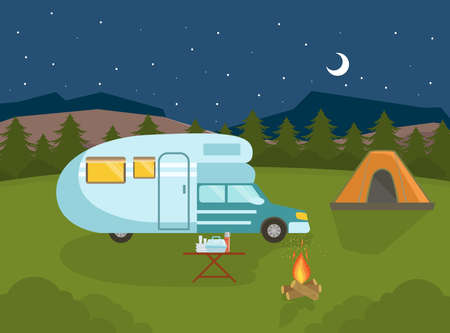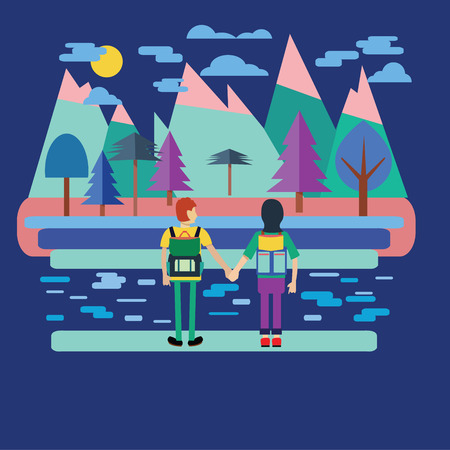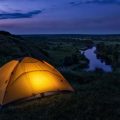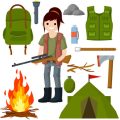1. Consider the Terrain
When youre setting up camp, one of the most important things to think about is the terrain. Picking the right ground can make or break your camping experience. You’ll want to find a spot that’s flat and even, without rocks, roots, or any sharp objects underneath your tent. Not only will this help you sleep better, but it also keeps you safe from injuries and prevents damage to your gear.
Why Level Ground Matters
Sleeping on uneven ground can be uncomfortable and may cause back pain or sore muscles by morning. Worse, if your tent is pitched on a slope, you might find yourself sliding around all night. A level surface helps keep your sleeping bag and gear in place and allows for better rest.
What to Avoid
| Terrain Feature | Why to Avoid |
|---|---|
| Rocks | Create pressure points under your tent and can tear the floor fabric. |
| Roots | Make sleeping uncomfortable and can poke through thin ground tarps. |
| Slope | Makes it hard to stay in one place while sleeping; water runoff risk if it rains. |
| Debris (sticks, pinecones, etc.) | Adds discomfort and may damage your gear. |
Pro Tip
If youre at a campground with designated sites, walk around your chosen area before setting anything up. Use your foot or a small broom to clear away debris and double-check that the surface is as flat as possible. Carrying a small foam pad or extra tarp can also help smooth out minor uneven spots for added comfort.
2. Check for Natural Shelter and Shade
When picking the perfect spot to pitch your tent, it’s smart to take advantage of what nature already offers. Trees, bushes, hills, and even large rocks can provide natural shelter from wind and much-needed shade during hot afternoons. However, while these features can make your camping experience more comfortable, they can also pose risks if youre not careful.
Why Natural Shelter Matters
Natural shelters help block strong winds that could shake or even damage your tent. They also offer protection from the sun, keeping your tent cooler during the day. This is especially important in warmer climates or during summer months when heat can build up inside your tent fast.
What to Look For
Here are some tips to keep in mind when using natural features for shelter and shade:
| Feature | Benefits | Things to Watch Out For |
|---|---|---|
| Trees | Provide shade and some protection from rain and wind | Avoid trees with dead branches (“widowmakers”) that might fall |
| Bushes/Shrubs | Block light winds and offer a bit of privacy | Watch out for thorns or bugs like ticks hiding in them |
| Hills/Ridges | Can block strong winds and add privacy | Avoid low spots near hills where water may collect if it rains |
| Boulders/Rocks | Create windbreaks and sometimes offer partial shade | Check stability—avoid areas with loose rock that could shift or fall |
Pro Tip:
If you’re setting up camp in the afternoon, pay attention to where the sun is moving. Try to pick a spot that will stay shaded in the morning too—waking up with the sun blaring into your tent isn’t fun!
Safety Reminder:
Always look up before setting up under trees. Dead limbs can fall without warning, especially if there’s wind overnight. It’s better to set up a little farther away than risk injury from falling debris.
By using natural shelter wisely, you’ll enjoy a more comfortable—and safer—camping experience.

3. Evaluate Proximity to Water
Choosing a tent site close to a water source like a river, lake, or stream can be super convenient. Youll have easy access to water for cooking, cleaning, and drinking (after proper treatment). But while being near water is helpful, its important to set up your tent at a safe distance—at least 200 feet away. This helps prevent contamination of the water and protects you from unexpected flooding, especially during heavy rain.
Why Distance from Water Matters
| Reason | Explanation |
|---|---|
| Water Safety | Staying 200 feet away helps keep natural water sources clean and free from soap, food waste, or human waste. |
| Flood Risk | Being too close to water puts your tent at risk during sudden rainstorms or rising water levels overnight. |
| Wildlife Encounters | Animals often visit water sources. Keeping your distance lowers the chance of unwanted animal encounters. |
How to Estimate 200 Feet Without a Measuring Tape
If you don’t have a tape measure with you, use this simple trick: take about 70 adult steps (each about 2.5–3 feet long) away from the water. That should give you roughly 200 feet of distance.
Bonus Tip:
Look for slightly elevated ground when pitching your tent near a water source. This helps with drainage and keeps your gear dry if the weather turns wet.
4. Assess Emergency Access and Visibility
When picking the perfect spot to pitch your tent, it’s not just about comfort and scenery—you also need to think about safety and accessibility. Emergencies can happen, and being prepared means choosing a location that first responders could reach if needed. It should also be visible enough for others to find you without sacrificing too much privacy.
Why Emergency Access Matters
If someone in your group gets injured or sick, getting help quickly is critical. Your tent site should be close enough to trails, roads, or ranger stations so that emergency services can reach you without delay. Avoid isolated spots deep in rough terrain where access would take hours.
Visibility vs. Privacy
You want your campsite to be visible enough so others can locate you in case of an emergency—especially if youre camping solo or in a remote area. At the same time, you don’t want to be right on top of the trail or parking lot where everyone walks by. Finding the right balance is key.
Tips for Balancing Safety and Seclusion
| What to Consider | Best Practice |
|---|---|
| Distance from main trail or road | Stay within 200 feet—close enough for access but far enough for peace |
| Visibility from above (drones/helicopters) | Avoid dense tree cover if youre in a high-risk area |
| Line of sight to landmarks | Set up near natural markers like large rocks or clearings |
| Campsite signage or markers | Use visible gear colors or a flag if youre in a secluded zone |
Pro Tip:
If youre camping in national parks or designated campgrounds, check with rangers about safe zones known for good visibility and fast response access. They often have maps showing the best areas for both privacy and safety.
By keeping emergency access and visibility in mind, you’re not only making your trip safer—you’re also giving yourself peace of mind while enjoying nature.
5. Mind Local Wildlife and Regulations
When picking the perfect spot to pitch your tent, its important to think about more than just the view or how flat the ground is. In many parts of the U.S., wildlife is a big part of the camping experience—and sometimes, that means being extra careful about where you set up.
Avoid Wildlife Hotspots
Animals use certain paths regularly, called game trails. These are often narrow tracks through grass or brush and can look like small, worn paths. Setting up too close to these can put both you and the animals at risk. Also, thick brush may seem like a cozy, private area, but it can be home to insects, snakes, or even larger animals.
Places to Avoid:
| Location | Why to Avoid |
|---|---|
| Animal trails | Regularly used by wildlife; possible encounters |
| Dense brush | Can harbor ticks, snakes, or nesting animals |
| Near water sources | Wildlife may visit for drinking; human presence can disturb them |
Follow Campground Rules and Backcountry Guidelines
Whether youre in a developed campground or exploring off-grid in the backcountry, always follow posted rules. These regulations are there to protect natural habitats and keep you safe. In national parks or forests, certain areas might be off-limits to camping entirely—often because of wildlife activity or efforts to restore vegetation.
Helpful Tips:
- Check park websites or ranger stations for local rules before heading out.
- Pack out all trash and food scraps—don’t attract wildlife.
- If youre using a bear canister or hanging food, do it at least 200 feet from your tent.
By respecting wildlife and following regulations, you’ll help preserve the outdoors while enjoying a safer and more peaceful camping trip.


